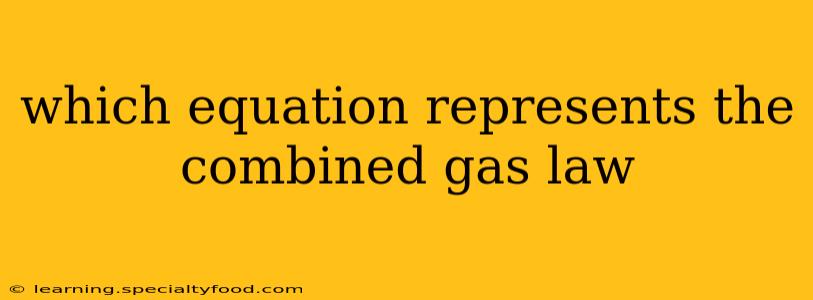Which Equation Represents the Combined Gas Law?
The combined gas law is a single equation that combines Boyle's Law, Charles's Law, and Gay-Lussac's Law to describe the relationship between pressure, volume, and temperature of a fixed amount of gas. It's a powerful tool for predicting how gases will behave under changing conditions. But which equation actually represents it? Let's break it down.
Understanding the Individual Gas Laws:
Before diving into the combined gas law, it's helpful to understand the three laws it brings together:
-
Boyle's Law: At constant temperature, the volume of a gas is inversely proportional to its pressure. Mathematically: P₁V₁ = P₂V₂
-
Charles's Law: At constant pressure, the volume of a gas is directly proportional to its absolute temperature (in Kelvin). Mathematically: V₁/T₁ = V₂/T₂
-
Gay-Lussac's Law: At constant volume, the pressure of a gas is directly proportional to its absolute temperature (in Kelvin). Mathematically: P₁/T₁ = P₂/T₂
The Combined Gas Law Equation:
The combined gas law cleverly merges these relationships into a single equation:
P₁V₁/T₁ = P₂V₂/T₂
where:
- P₁ is the initial pressure
- V₁ is the initial volume
- T₁ is the initial absolute temperature (in Kelvin)
- P₂ is the final pressure
- V₂ is the final volume
- T₂ is the final absolute temperature (in Kelvin)
This equation allows us to calculate the effect of changing any two of the three variables (pressure, volume, or temperature) on the third, while keeping the amount of gas constant.
Frequently Asked Questions (FAQs): Addressing Common Queries
Here are some frequently asked questions about the combined gas law:
What are the limitations of the combined gas law?
The combined gas law, like the individual gas laws it combines, is an ideal gas law. This means it works best for gases behaving ideally – meaning they have negligible intermolecular forces and occupy negligible volume compared to the container volume. Real gases deviate from ideal behavior at high pressures and low temperatures, so the combined gas law might not be perfectly accurate in those conditions.
Why must temperature be in Kelvin?
Using Kelvin (the absolute temperature scale) is crucial because temperature in the combined gas law represents the average kinetic energy of the gas molecules. The Kelvin scale starts at absolute zero, where theoretically, all molecular motion ceases. Using Celsius or Fahrenheit would yield incorrect results because they have arbitrary zero points.
How do I use the combined gas law to solve problems?
Solving problems using the combined gas law generally involves identifying three known variables and one unknown variable. Then, plug the known values into the equation and solve algebraically for the unknown. Remember to always convert temperatures to Kelvin before calculation.
Can the combined gas law be used with a changing amount of gas?
No. The combined gas law only applies to a fixed amount (number of moles) of gas. If the amount of gas changes, you'll need to use a different equation, such as the ideal gas law (PV = nRT).
By understanding the derivation and applications of the combined gas law, you'll be well-equipped to tackle a wide range of gas behavior problems. Remember to always keep in mind the limitations of this ideal gas approximation.
